|
|
|
Basic Characteristics of Grass Flowers
|
|
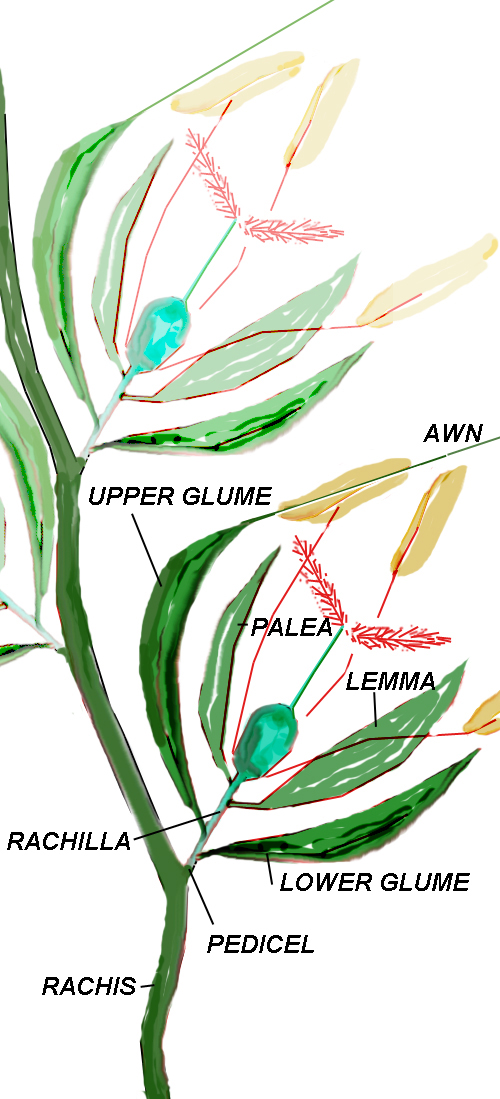
|
As noted on the previous page on basic characteristics and terms related to grass plants, most structural details concerning grasses will be covered as needed at various points in the key. Here, we introduce the basic terminology used to describe a grass flower and the arrangement of flowers on the plant. These characteristics are extremely variable from species to species but, within a usually narrow range, consistent for a given species. Consequently, while leaf shape, growth form, size, etc. are all potentially useful in describing a grass plant, it is the details of flower structure and flower arrangement that are the definitive characteristics used to identify a grass species. The information given on this page is critical to using our key and mastering grass identification.
Figure G. Idealized grass spikelets in exploded view to demonstrate arrangement of parts: a single floret consists of the ovary (blue-green) with two stigmas (feathery red), and three anthers (yellow-tan) on thin filaments (red); and these parts are enclosed by the palea and lemma (floral bracts). One or more florets are attached to the rachilla above the upper and lower glumes. The glumes and one or more florets constitute a spikelet attached to the rachis. Of course, in reality these parts are all packed tightly together.
|
|
The terminology pertaining to the structure and arrangement of flowers in the grasses can be viewed in a hierarchical sense, as steps of increasing complexity starting with the flower itself, termed a floret because it is typically one unit in a structure of several to many such units that would be observed as the "flower". The floret (see Fig. G) consists of two surrounding bracts or scales termed the lemma and the palea), a pistil (the ovary with two feathery stigmas), and two or three stamens (pollen-producing anthers on long filaments). Any of the parts may be lacking or reduced in some spikelets of some species of grass. Although such details are not readily observed without a hand lens or microscope, they can be critical in differentiating between closely related species (that is, within a genus).
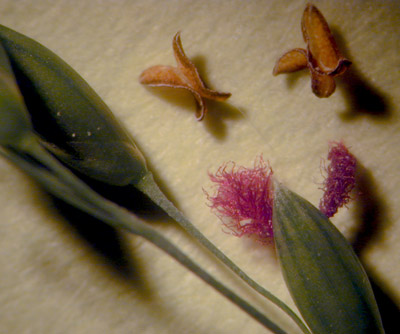
Figure H. View of a grass "flower" through a microscope: two (and the base of another) spikelets are shown, the one on the right in anthesis, when the anthers (on thin filaments) protrude from a floret within the bracts of the spikelet. Two red, feathery stigmas are also protruding.
Florets are grouped within a structure called a spikelet (Figures H, J, and K). The spikelet is a basic floral structure and it is critical to understanding and working the key to recognize the spikelet unit when examining a grass flowering structure (= the inflorescence). A spikelet consists of one or more florets attached to a central rachilla—typically each floret in a spikelet will have its own lemma and palea (see Fig. G, above). At the base of the florets in a spikelet is a pair of bracts called glumes. Glumes can be quite variable in size and shape between species. They can be large or small in relation to the florets, and much reduced or even missing in some species.
|
|
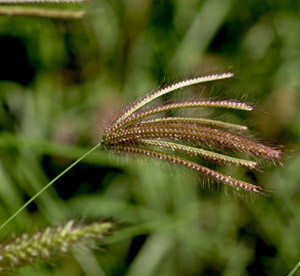
Figure I. The inflorescence of a common grass, Chloris barbata. In this species the infloresence consists of multiple, feathery spikes, each spike with numerous, crowded spikelets; the spikes are arranged digitately (coming off at a common point like fingers or digits on a hand).
The inflorescence of a grass consists of one or more (often a great many) spikelets arranged in a specific way at the upper end of a stem called the culm (or axis or peduncle within the inflorescence). In many grasses the spikelets are attached at the ends of small stalks called pedicels. If these are branched, the terms branch or ray may apply to the part supporting multiple pedicels. Spikelets are often arranged in relatively tight groupings on a stem called a rachis. If the spikelets attach to the rachis directly, the structure is called a spike; if the spikelets attach by short stalks (again, the pedicels), the structure is called a raceme. Because it can be difficult to see short pedicels, the difference between a spike and a raceme is seldom critical in using the grass key. Anyway, some grasses have the spikelets paired, with one sessile (as on a spike) and one on a pedicel (as on a raceme).
A raceme or spike may be single and terminal on a culm; or several to many racemes or spikes may be spread along or clustered on the culm. If the spikelets are at the ends of branches coming off the culm, the inflorescence is called a panicle, which is a branching peduncle. If the branches are very short, the panicle might be called spike-like, meaning it looks like a spike. However, a culm with many separate spikes or racemes branched off the axis is also a panicle (actually a "panicle of spikes" or a "panicle of racemes"). Most grass inflorescences are panicles of one sort or another. This discussion of inflorescence types continues within the grass key on page 4.
|
|
|
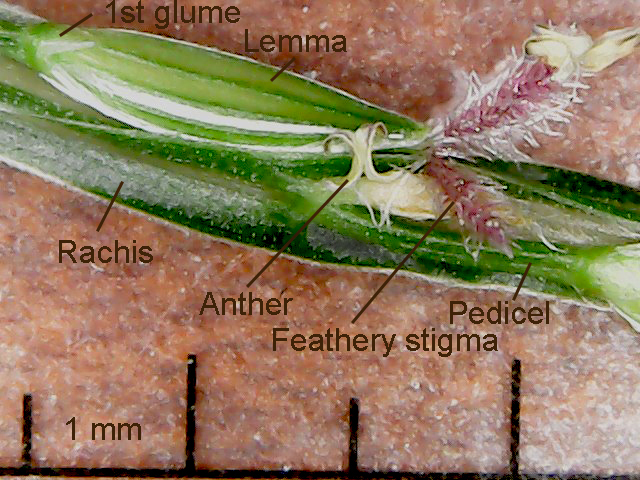
|
Figure J. Digiteria spikelet in anthesis, with visible parts labeled. Note that next spikelets on right are paired, one (undeveloped, whitish, under stigma) on a short pedicel, other on a long pedicel. This image is repeated as Figure 7B with a more detailed description particularly germain to identifying Digiteria species.
|
|
|
|
Figure K (right). Portion of inflorescence of perennial ryegrass showing six spikelets, each with 6-7 florets enlosed between the glumes (upper glume more less hidden against rachis).
|
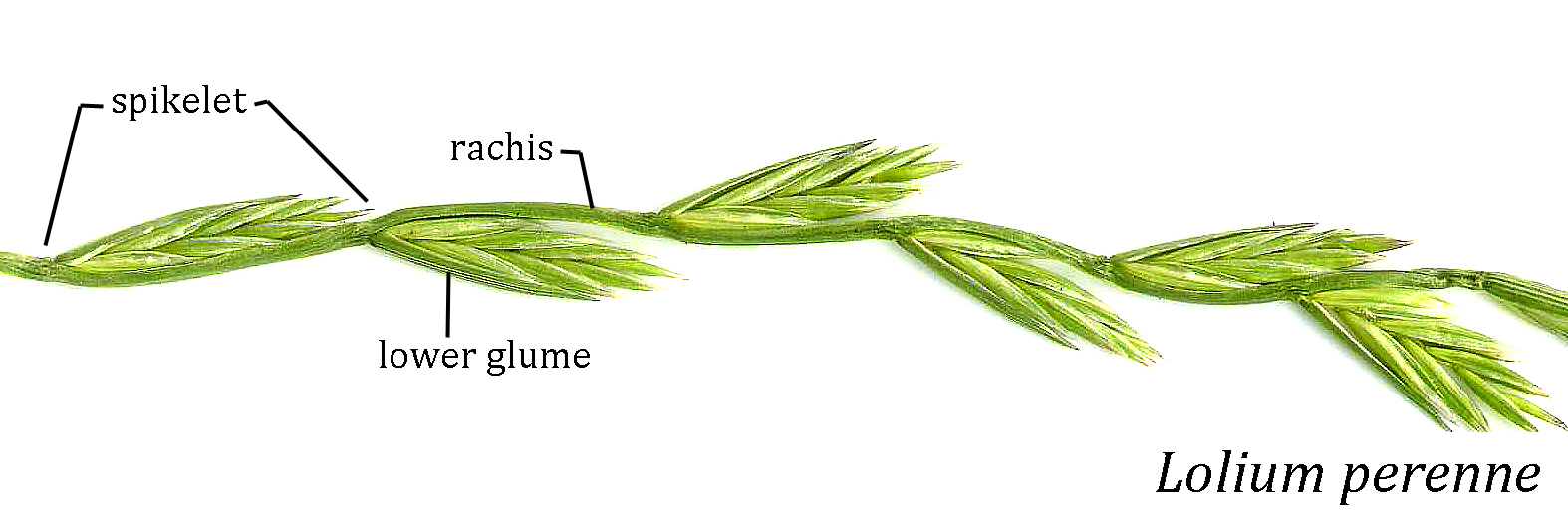
|
|
|
HAWAI‘I USERS
 INTRODUCTION INTRODUCTION
 TABLE OF CONTENTS TABLE OF CONTENTS
 GRASS KEY GRASS KEY
|
GUAM USERS
 INTRODUCTION INTRODUCTION
 TABLE OF CONTENTS TABLE OF CONTENTS
 GRASS KEY GRASS KEY
|
|